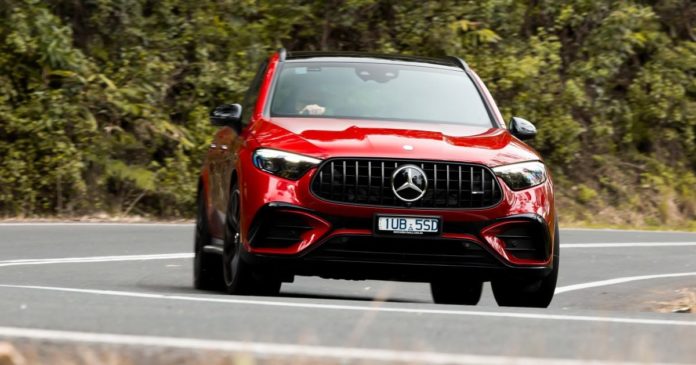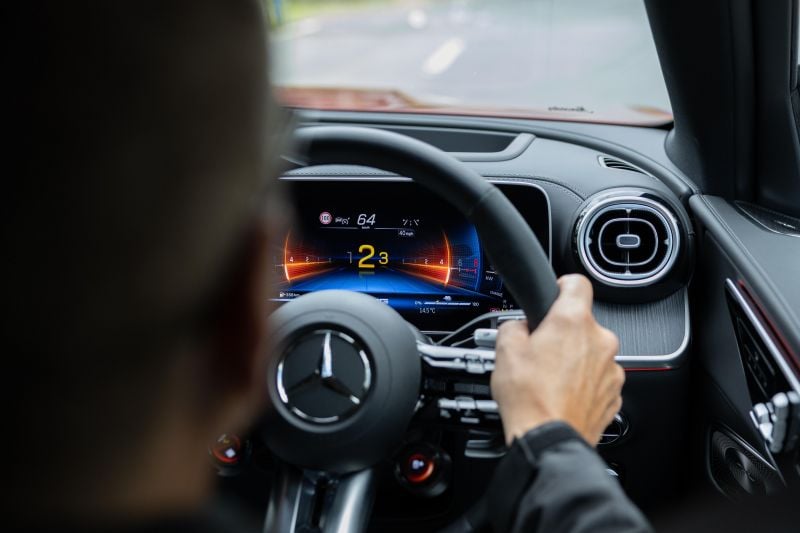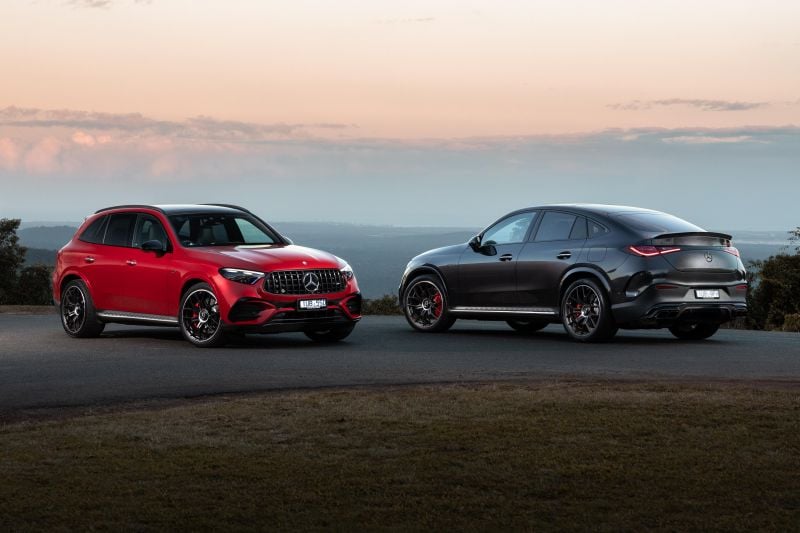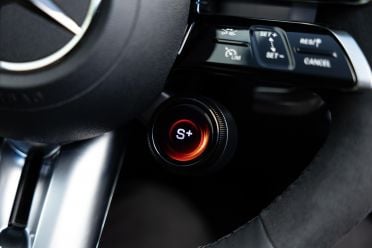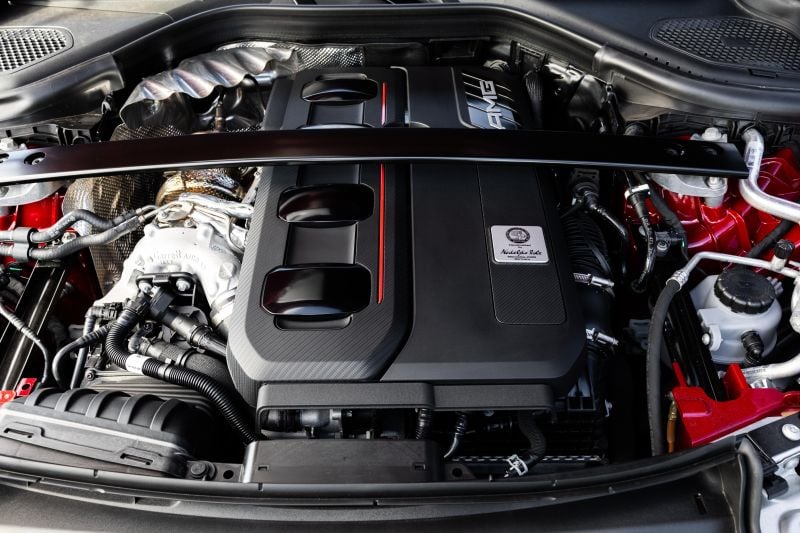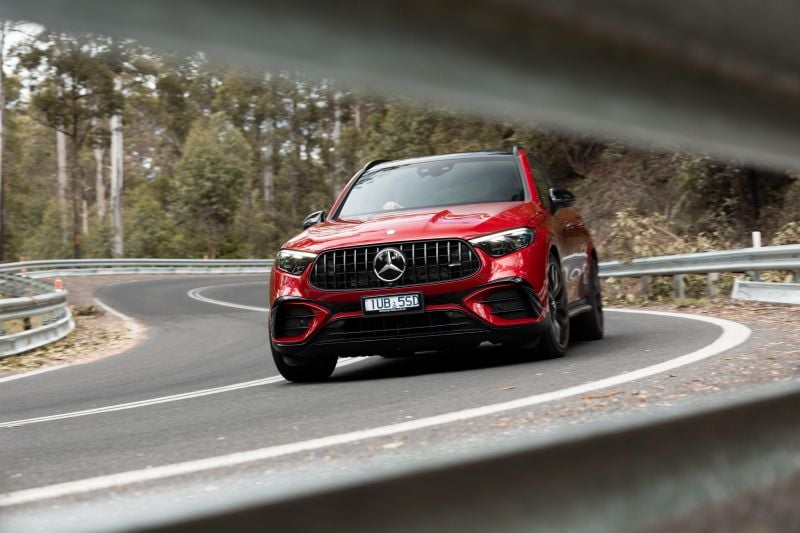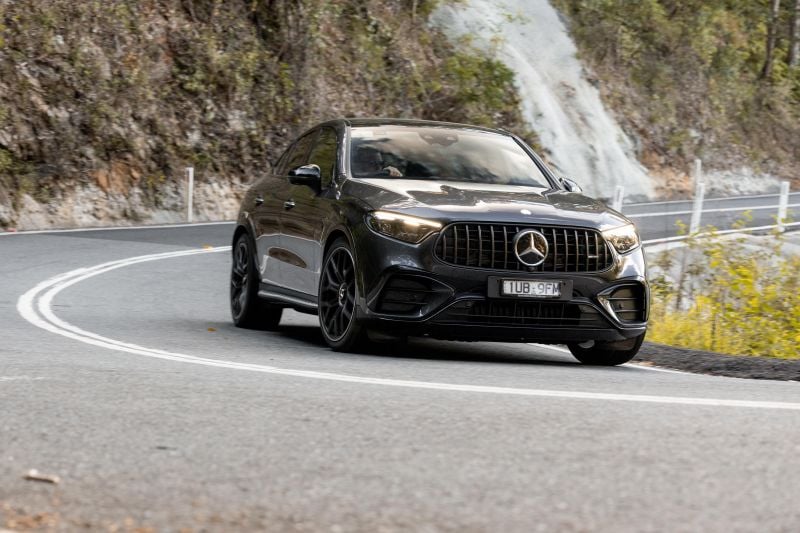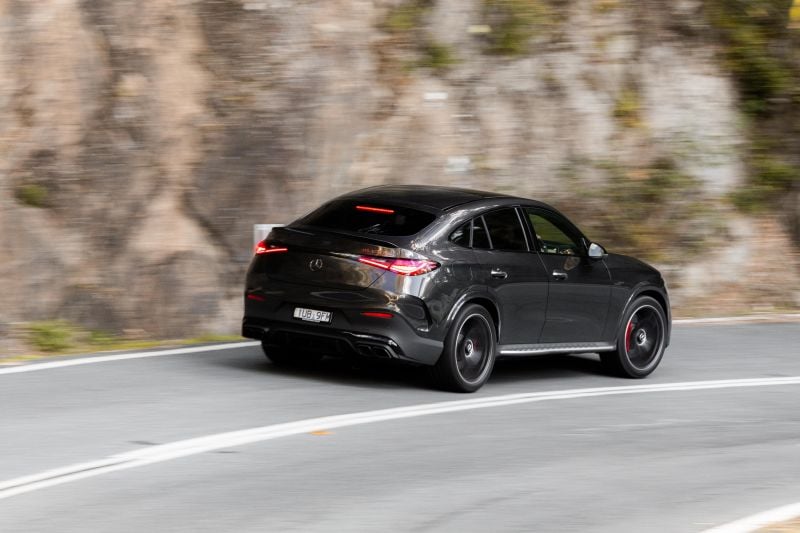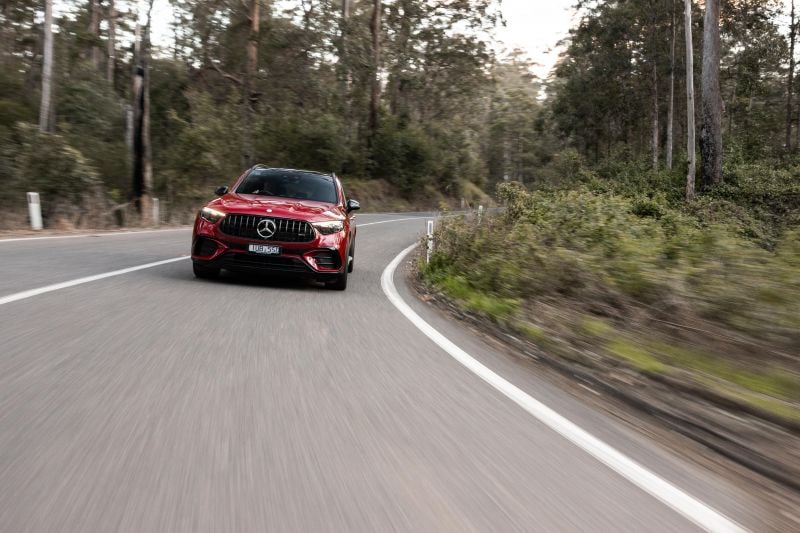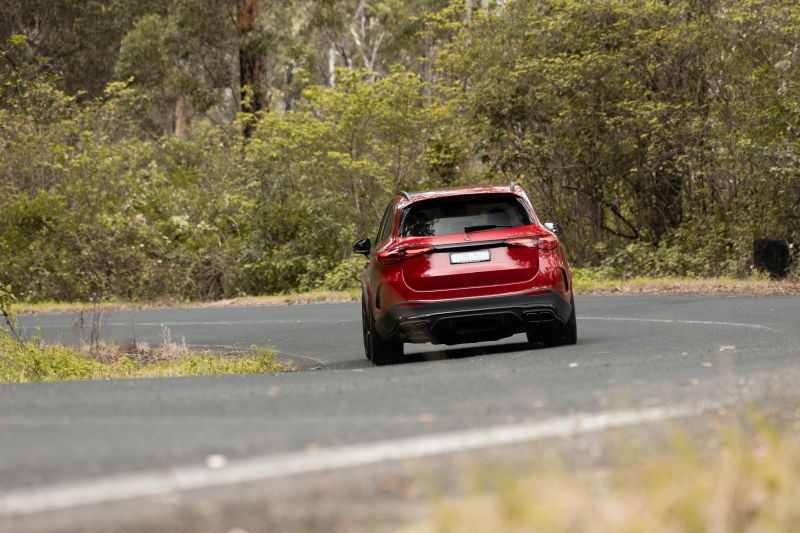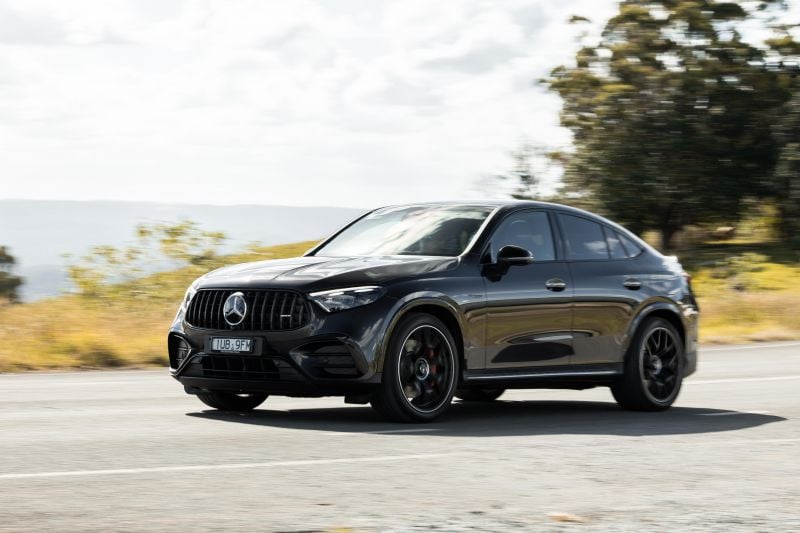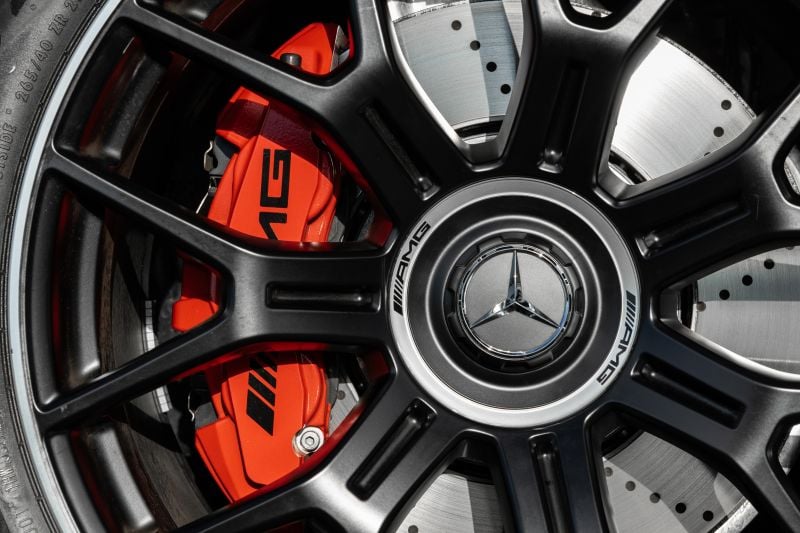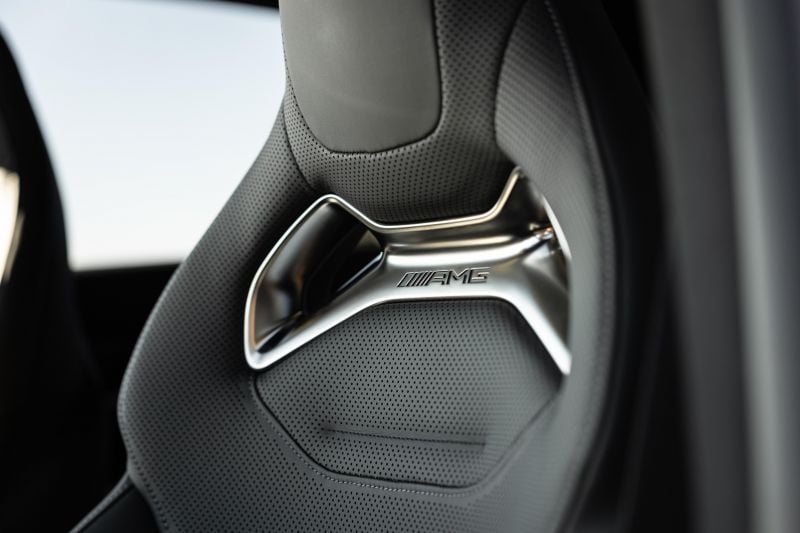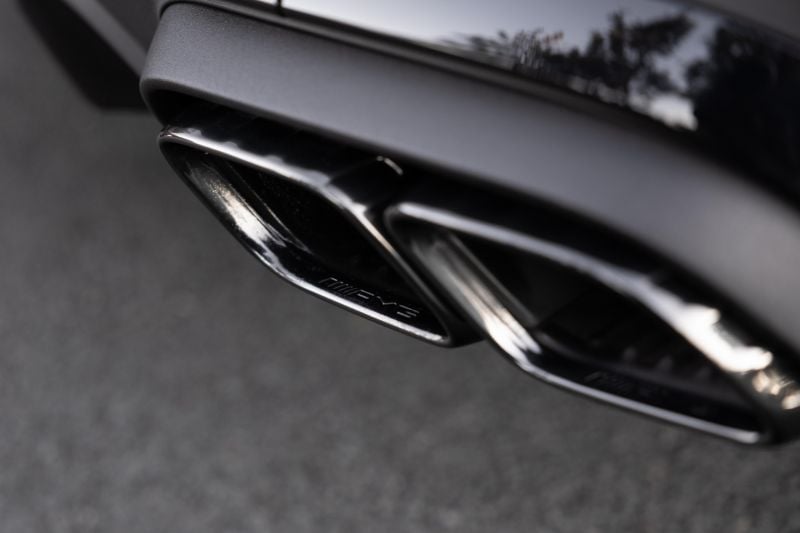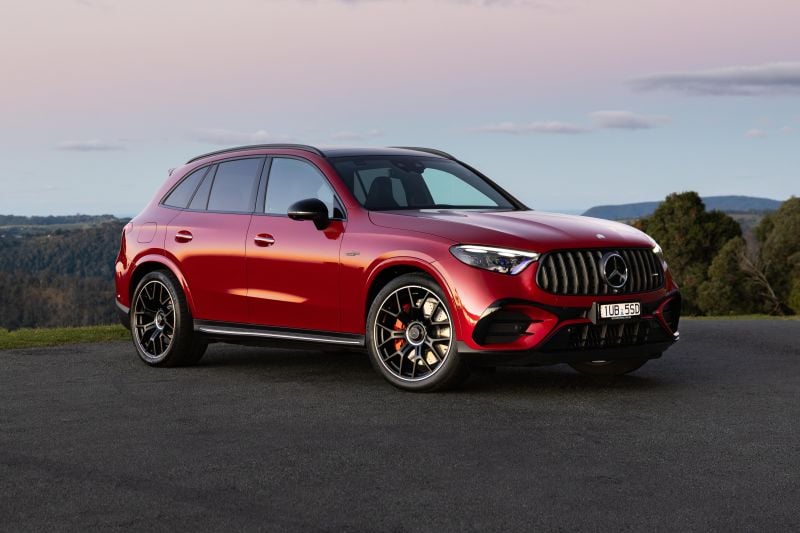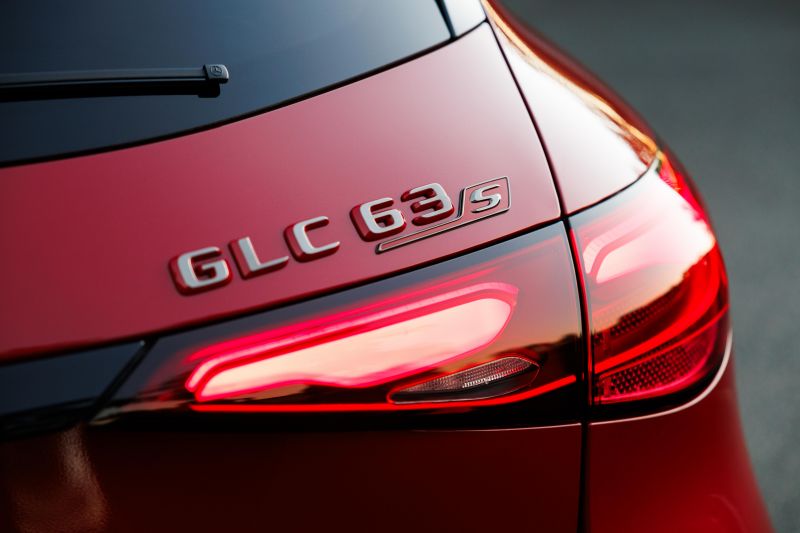Yes, we know – it’s sad to see another V8 go.
The Mercedes-AMG GLC 63 S E Performance is the brand’s new high-performance mid-sized SUV, ditching the twin-turbocharged V8 of the old AMG GLC 63 in favour of a turbocharged four-cylinder plug-in hybrid powertrain.
It follows the same playbook as the new C 63, which it’s closely related to. As with the wider C-Class range, all GLCs pack four-cylinder power, with the GLC 63 sitting above the GLC 43 which features the same engine but without the plug-in hybrid system.
The four squared-off (instead of round) exhaust outlets are the biggest giveaway this isn’t the GLC 43, but like its less expensive sibling this is a very subtle-looking performance SUV. Those useless side steps are a bit silly though.
As with the GLC 43, there’s a choice of more traditional SUV or coupe SUV body styles, with the latter arguably doing a better job of looking like a coupe than its predecessor – those tail lights could have come straight from the new CLE Coupe.
The mid-sized high-performance SUV segment is undergoing a huge transformation right now, and the GLC 63 has gone from being the only V8-powered model to being the only plug-in hybrid (PHEV).
The BMW X3 and X4 stick with a twin-turbocharged inline six-cylinder engine in hot M guise, and rumour has it these high-performance SUVs won’t be directly replaced.
The Maserati Grecale Trofeo and Alfa Romeo Stelvio Quadrifoglio also have twin-turbo sixes, while Audi still hasn’t launched an RSQ5 which leaves only the tamer SQ5. Finally, Porsche’s petrol-powered Macan is heading out the door, to be replaced later this year with an electric-only model.
The GLC 63 therefore is quite a unique offering in the segment. Is it the one to pick?
How does the Mercedes-AMG GLC compare?
View a detailed breakdown of the Mercedes-AMG GLC against similarly sized vehicles.

Mercedes-AMG
GLC
How much does the Mercedes-AMG GLC 63 cost?
The GLC 63 is a bit more expensive than rivals from BMW and Maserati, though it’s more powerful than any of them.
| Model | Price before on-road costs |
|---|---|
| Mercedes-AMG GLC 63 S E Performance | $192,900 |
| Mercedes-AMG GLC 63 S E Performance Coupe | $199,500 |
To see how the Mercedes-AMG GLC 63 lines up against the competition, check out our comparison tool.
What is the Mercedes-AMG GLC 63 like on the inside?
The GLC 63’s interior isn’t dramatically different from lesser GLCs.
Let’s start with what is different. There are wonderfully comfortable, supportive AMG sports seats finished in Nappa leather, which feature heating but no ventilation or massage. You can also opt for racier AMG Performance seats.
The standard AMG Performance steering wheel feels terrific, with a thick, perforated Nappa leather rim and AMG’s little rotary controls towards the bottom. The touch-capacitive switches are okay, but we’d prefer traditional buttons and toggles.
There are also various AMG- and hybrid-specific screens on the 11.9-inch infotainment touchscreen and the 12.3-inch digital instrument cluster.
Otherwise, this is standard GLC (and C-Class, and EQE SUV, and EQE, etc) fare. That means an interior that is flashy and majors on showroom appeal, but has a small handful of disappointing elements once you scratch past that glitzy surface.
On the topic of scratching, the vast swathe of piano black trim on the centre console seems especially susceptible to it, as well as fingerprint smudges and dust.
Look, Mercedes-Benz is far from alone in using this material. But what makes its application so perplexing here is that there’s a sea of wood trim across the dashboard which they could have used here instead. There’s also genuinely attractive, tactile metal trim used around the window switches which we wouldn’t mind seeing more of.
The Edition 1 includes some enticing additions inside the cabin. The steering wheel features carbon fibre and microfibre, there are various yellow highlights such as the contrast stitching and seatbelts, and that forest of wood on the dash becomes a sea of carbon fibre.
Personally, I’m not usually a fan of carbon-fibre trim as it feels a bit cliche at this point, but the stuff in the Edition 1 is genuinely attractive. Note you don’t have to go for the Edition 1 to get the trim or features like the carbon-fibre/microfibre steering wheel and multicontour performance seats, as these are available in other option packages.
Given how close this is to the GLC 300 inside, a car which costs around half the price, there are a few issues that are especially bothersome in the more expensive GLC 63.
The button to open the centre console bin, as we’ve noticed in various Mercedes models, feels very cheap. The lowest reaches of the dash and doors are also finished in hard plastic – tolerable in a circa-$100k GLC 300, less so in a circa-$200k AMG GLC 63.
However, overall cabin presentation, like the cheaper GLC, is good. There’s a soft-touch dash top with stitching details, as well as soft-touch trim on the sides of the centre console. The squircle air vents are attractive, as are the metallic speaker grilles, and there is of course Mercedes’ flashy ambient lighting.
The technology is also top-notch. The infotainment system is generally quite easy to navigate, with climate controls always anchored to the bottom of the screen in the absence of physical switches.
The digital instrument cluster also offers a range of different display modes, all of which feature attractive graphics.
Step into the back and you’ll find a spacious second row. There’s noticeably less headroom in the Coupe, however, as well as worse visibility out of the rear window due to the sloping roofline.
There aren’t separate climate controls back here, though there are air vents plus USB outlets and a fold-down centre armrest with cupholders. If you want to fit a child seat, you can use one of three top-tether or two ISOFIX anchor points.
Boot space is down on lesser GLCs due to the large battery. It’s also down 110L on the previous-generation model, regardless of what body style you choose, and that’s despite the new GLC being between 44mm and 67mm longer overall.
-

GLC 63 -
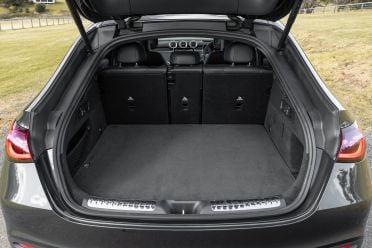
GLC 63 Coupe
| Dimensions | GLC 63 | GLC 63 Coupe |
|---|---|---|
| Length | 4749mm | 4792mm |
| Width | 1920mm (2076mm incl. mirrors) | 1920mm (2076mm incl. mirrors) |
| Height | 1635mm | 1603mm |
| Wheelbase | 2888mm | 2888mm |
| Cargo capacity | 470-1530L | 390-1335L |
To see how the Mercedes-AMG GLC 63 lines up against the competition, check out our comparison tool.
What’s under the bonnet?
As with the new C 63 S E Performance, the GLC 63 packs a version of the turbocharged 2.0-litre four-cylinder ‘M139’ engine from the AMG A 45 S that is the most powerful production four-cylinder engine in the world.
This is mated with a rear-mounted electric motor with 150kW of peak power and 320Nm of torque (or 80kW of continuous power), fed by a 6.1kWh lithium-ion battery pack. A turbocharger is driven by not only exhaust gases, but also by a 48V electrical system.
Compared to the old GLC 63, the new car has 125kW more power and 320Nm more torque in total, and is also 0.3 seconds quicker to 100km/h.
| Specifications | Mercedes-AMG GLC 63 S E Performance |
|---|---|
| Engine | 2.0L turbo four-cylinder |
| Engine outputs | 350kW / 545Nm |
| Electric motor outputs | 150kW / 320Nm |
| System outputs | 500kW / 1020Nm |
| Battery | 6.1kWh lithium-ion |
| Transmission | 9-speed automatic 2-speed automatic integrated with electric motor |
| Driven wheels | All-wheel drive |
| Weight | 2338-2366kg |
| Fuel economy (claimed) | 7.3L/100km |
| Fuel economy (as tested) | 12.8L/100km |
| Electric driving range (PHEV) | 14km |
| Electric energy consumption (claimed) | 9.8kWh/100km |
| Fuel tank capacity | 65L |
| Fuel requirement | 98 RON |
| CO2 emissions | 166g/km |
| Emissions standard | Euro 6 |
| Braked towing capacity | 1800kg |
To see how the Mercedes-AMG GLC 63 lines up against the competition, check out our comparison tool.
How does the Mercedes-AMG GLC 63 drive?
I got into the GLC 63 S E Performance with three concerns: that it was going to feel overly heavy and ponderous; that it was going to have a lumpy ride on account of the large battery pack and low-profile tyres; and that it wasn’t going to sound all that good.
Driving this new-generation performance SUV, however, has assuaged most of my concerns.
Let’s address the elephant in the room: the sound. After all, that’s one of the best things about a V8, right?
Make no mistake, the new GLC 63 doesn’t sound as good as the old one – that doesn’t mean it sounds bad, however.
Mercedes-AMG has installed a pressure sensor within the exhaust that it says allows it to pick up the engine note and transfer it to the speaker system inside the car.
You can manually toggle an amplified version of the engine note in either the vehicle settings menu or by using one of the steering wheel toggles, and it goes from sounding like a typical turbocharged four-cylinder Benz to sounding, well, pretty good.
Ok, not V8 good, but it makes the GLC 63 louder, more dynamic-sounding and yet easy on the ears. You also get some tasty pops and crackles.
When you’re running on pure electric power, there’s a futuristic, spaceship-y noise.
As you’d expect, the GLC 63 is very fast given it takes the most powerful production four-cylinder engine in the world and then mates it to an electric motor.
Our drive route took us along some of the best driving roads in South East Queensland, including through Mount Nebo and Mount Glorious, in a GLC 63 Coupe.
First, however, we had to get through peak-hour Brisbane traffic, which revealed just how versatile these performance plug-in hybrids are.
You can zip around on pure electric power at speeds up to 120km/h, though you only have a claimed 14km of electric range. You can plug the GLC in and recharge the battery using AC power at up to 3.7kW, or use the petrol engine to top it up.
There are so many drive modes to choose from, selectable using a handy wheel on the steering wheel. These comprise Slippery, Individual, Battery Hold, Electric, Comfort, Sport, Sport+ and Race modes.
What this means is if your spouse is a tame driver and you’re more adventurous, you have this excellent dichotomy whereby they can drive it in Comfort or Electric and find it thoroughly unintimidating, and then you can get in, pop it into Sport+, and fang it.
We kept it in Comfort mode around town, and then flicked it to Sport+ when the roads got more interesting.
While driving around at lower speeds, we found the transition between petrol and electric power to be very smooth.
If you want, you can configure your own Individual setting. Choose between Battery Hold, Electric, Moderate, Sport, Dynamic and Race for drive; Comfort, Sport and Sport+ for suspension; and, for AMG Dynamics, Basic, Advanced, Pro and Master levels.
By adjusting the AMG Dynamics level, you’re altering the calibration of the stability control, the all-wheel drive system, and the electronically controlled limited-slip differential.
It all sounds a bit complicated, doesn’t it? Well, yes, but it also means there’s a seemingly endless amount of customisation on offer, so you can tailor the car just the way you want it.
There’s meaningful differentiation between the drive modes, too. For example, thanks to the adaptive dampers, the ride, while still firm, is much more pliant in Comfort mode with almost a hint of float, in contrast with the stiff feel you get in Sport+.
The steering always has a nice weighting to it. Turn-in is sharp, and there’s plenty of road feel here.
We wish the brake pedal felt better, however. When we went to give the GLC 63’s pedal a stab before a corner, we found it felt rather spongey. The brakes themselves are excellent, our criticism is with the feel of the pedal.
The GLC 63 weighs a sizeable 250kg or so more than its predecessor, largely due to that battery pack. But Mercedes-AMG engineers have nevertheless improved the weight distribution, which has gone from 55:45 front/rear to 49:51; the electric motor is situated on the rear axle.
Torque is distributed anywhere from 50/50 front/rear all the way up to 100 per cent to the rear.
The GLC 63 features rear-axle steering, which can move the rear wheels in the opposite direction to the front wheels by 2.5 degrees at speeds of up to 100km/h; likewise, they can move in parallel to the front wheels at an angle of 0.7 degrees at speeds above 100km/h.
All of this makes the GLC 63 sound very impressive on paper, but I was nevertheless still surprised how nimble it felt.
You can carry a lot of speed into corners due to the excellent grip and almost complete lack of body roll. You might sit slightly high but this doesn’t really feel like an SUV to drive.
That instantaneous grunt also means you can propel yourself out of a corner with impressive ease.
Even the standard AMG sports seats hug you in place in the corners, so the optional performance seats hardly seem necessary.
The cabin is quiet, even at highway speeds, unless you’re on a coarse-chip surface. That’s when tyre roar becomes quite loud.
Mercedes-AMG has stressed this isn’t an efficiency-focused hybrid, and with observed fuel consumption of 12.8L/100km this is no miser – still, it could be a lot worse.
The official claim is 7.3L/100km, compared to 12.2L/100km with the old V8 car.
To see how the Mercedes-AMG GLC 63 lines up against the competition, check out our comparison tool.
What do you get?
The Mercedes-AMG GLC 63 S E Performance is the flagship variant in the range.
GLC 63 S E Performance highlights:
- 21-inch forged wheels
- AMG Active Ride Control suspension
- AMG Night Package II with darkened grille, black chrome badging
- AMG Track Pace track data logging
- AMG Driver’s Package
- Semi-autonomous parking assist
- Panoramic sunroof
- LED headlights with adaptive high-beam
- Nappa leather upholstery
- Heated front seats
- Power-adjustable front seats with four-way lumbar
- Head-up display
- AMG Performance multifunction steering wheel
- 11.9-inch MBUX touchscreen infotainment system
- Wireless Apple CarPlay and Android Auto
- Satellite navigation with augmented reality
- Burmester 3D sound system
- Dual-zone climate control
- Wireless phone charger
- 8m charging cable for domestic sockets
Options
There are a wide range of optional extras for the GLC 63 S E Performance.
The Edition 1 Package costs $12,900 and adds:
- Manufaktur graphite grey magno paint
- Foling with colour gradation
- AMG Aerodynamics Package
- Light-alloy wheels with Edition 1 and AMG labelling
- Yellow brake calipers
- Silver chrome fuel filler cap
- AMG indoor car cover with Edition logo
- AMG Performance seats
- Black Nappa leather upholstery with yellow contrast stitching, Edition logo
- Yellow seat belts
- Illuminated sill plates
- Carbon-fibre trim
- AMG Performance steering wheel with carbon fibre, microfibre
- Floor mats with Edition logo, yellow stitching
It removes the standard aluminium-look running boards.
You can get many of the Edition 1’s features in separate packages.
The Carbon Interior Package ($2600) adds:
- Carbon-fibre trim
- AMG Performance steering wheel with carbon fibre, microfibre
The Performance Ergonomic Package ($6900) adds:
- AMG Performance steering wheel in Nappa leather, Microcut microfibre
- AMG Performance multicontour front seats
A ceramic composite braking system is an additional $8300.
Is the Mercedes-AMG GLC 63 safe?
While the Mercedes-Benz GLC has a five-star safety rating from ANCAP, the AMG GLC range is thus far unrated.
Standard safety equipment includes:
- Autonomous emergency braking
- Adaptive cruise control
- Blind-spot monitoring
- Lane-keep assist
- Traffic light recognition
- Surround-view camera
- Front and rear parking sensors
How much does the Mercedes-AMG GLC 63 cost to run?
The Mercedes-AMG GLC 63 S E Performance is covered by a five-year, unlimited-kilometre warranty.
| Running costs | Mercedes-AMG GLC 63 S E Performance |
|---|---|
| Warranty | 5 years, unlimited kilometres |
| Roadside assistance | 5 years |
| Service intervals | 12 months or 20,000km |
| Capped-price servicing | Up to 5-year plans |
| Total capped-price service cost | $5025 (3yrs) $6455 (4yrs) $7180 (5yrs) |
To see how the Mercedes-AMG GLC 63 lines up against the competition, check out our comparison tool.
CarExpert’s Take on the Mercedes-AMG GLC 63
Compared with its predecessor, the new GLC 63 is heavier, more expensive and doesn’t sound as good.
It’s also quicker and more efficient. Mercedes-AMG has taken with one hand but given with another. It’s a thoroughly entertaining SUV to drive when you push it, and yet it can also be a placid and comfortable commuter.
V8 lovers may be disappointed with Mercedes-AMG’s decision to move to a plug-in hybrid four-cylinder, and indeed this move has brought extra weight and complexity.
However, it would be remiss of mid-sized performance SUV enthusiasts not to check out the new GLC 63.
Click the images for the full gallery
MORE: Buy a Mercedes-AMG GLC
MORE: Everything Mercedes-AMG GLC

